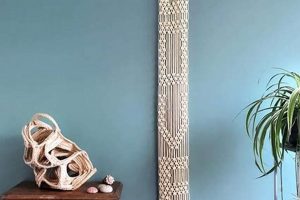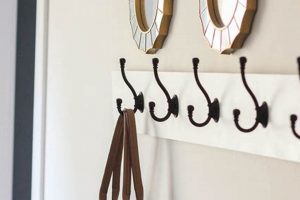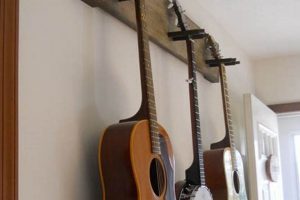The process of installing loose-fill insulation within existing wall cavities, undertaken by the homeowner, offers a method to improve a building’s thermal performance. This typically involves creating access points in the walls, injecting the insulation material (such as cellulose, fiberglass, or mineral wool), and then sealing the access points. This method contrasts with professional installation, where contractors typically use specialized equipment and have extensive experience.
Improving energy efficiency, reducing heating and cooling costs, and enhancing soundproofing are potential advantages. Implementing this independently may result in considerable savings relative to employing a professional service. Furthermore, it has a historical precedent in home improvement, reflecting a trend toward increasing self-sufficiency in property maintenance and renovation.
The subsequent sections will address the tools and materials required, the necessary safety precautions, the steps involved in the process, and considerations for assessing project suitability, all in detail.
Guidance for DIY Blown-in Wall Insulation
The successful implementation of loose-fill insulation in existing wall cavities requires careful planning and execution. Adherence to best practices is crucial for maximizing thermal performance and avoiding potential problems.
Tip 1: Material Selection: Choose the appropriate insulation material based on climate, building construction, and budget. Cellulose provides good recycled content and fire resistance, while fiberglass is generally more cost-effective. Mineral wool offers excellent fire resistance and sound dampening.
Tip 2: Air Sealing: Before injecting insulation, thoroughly air-seal any cracks, gaps, or penetrations in the walls. This minimizes air leakage and maximizes the insulation’s effectiveness. Caulk and expanding foam are useful for this purpose.
Tip 3: Proper Equipment: Utilize a suitable blower designed for loose-fill insulation. Renting or purchasing the correct equipment ensures proper density and consistent coverage within the wall cavities. Follow the manufacturer’s instructions carefully.
Tip 4: Cavity Preparation: Drill access holes strategically between studs to ensure complete filling of the wall cavity. Use a stud finder to locate studs accurately. The size and placement of the holes will depend on the insulation material and blower nozzle.
Tip 5: Insulation Density: Maintain the recommended insulation density throughout the wall cavity. Insufficient density reduces thermal performance, while excessive density can compress the material and reduce its R-value. Monitor the material usage to ensure correct fill.
Tip 6: Safety Precautions: Wear appropriate personal protective equipment (PPE), including a dust mask, eye protection, and gloves. Loose-fill insulation can irritate the skin and respiratory system. Work in a well-ventilated area.
Tip 7: Inspection and Sealing: After injecting the insulation, inspect the walls for any voids or settling. Top off any areas as needed. Seal the access holes with patching compound or plugs, ensuring a smooth and airtight finish.
Properly installed insulation can significantly improve a building’s energy efficiency and comfort. Attention to detail and adherence to safety guidelines are essential for a successful outcome.
The following section will explore the long-term maintenance and performance considerations of blown-in wall insulation.
1. Material Selection
The selection of insulation material is a foundational decision in any loose-fill insulation undertaking. It directly impacts the project’s thermal performance, cost-effectiveness, safety, and environmental impact. Choosing the appropriate material requires careful consideration of building characteristics, regional climate, and occupant preferences.
- R-Value and Thermal Performance
The R-value, a measure of thermal resistance, varies significantly among insulation materials. Cellulose generally offers a higher R-value per inch compared to fiberglass, leading to potentially superior insulation performance in colder climates. Mineral wool provides a comparable R-value with enhanced fire resistance. The required R-value should align with local building codes and energy efficiency goals.
- Material Density and Settling
The density of the insulation material influences its resistance to settling within the wall cavity. Higher density materials, such as mineral wool, are less prone to settling over time, maintaining consistent thermal performance. Settling can create uninsulated voids, reducing the overall effectiveness of the insulation and potentially leading to increased energy consumption.
- Fire Resistance and Safety
Fire resistance is a critical safety consideration. Mineral wool and certain treated cellulose products offer excellent fire resistance, providing valuable protection in the event of a fire. Fiberglass, while non-combustible, does not inherently prevent fire spread. Selecting a fire-resistant material can significantly enhance the safety of the building and its occupants.
- Environmental Impact and Sustainability
The environmental impact of insulation materials varies depending on their composition and manufacturing processes. Cellulose insulation, often made from recycled paper, offers a sustainable option with a lower carbon footprint. Fiberglass and mineral wool may incorporate recycled content, but their manufacturing processes can be energy-intensive. Choosing materials with recycled content and sustainable production practices minimizes the environmental impact of the project.
Consequently, informed material selection is crucial for optimizing the effectiveness, safety, and sustainability of loose-fill wall insulation. Consideration of R-value, settling, fire resistance, and environmental impact ensures that the chosen material aligns with the specific needs and priorities of the insulation project, leading to long-term energy savings and enhanced building performance.
2. Equipment Rental and DIY Blown-In Insulation
The successful completion of a self-managed loose-fill wall insulation project is heavily reliant on access to appropriate equipment, typically secured through rental services. The specialized nature of the tools, particularly the insulation blower, dictates this reliance. Standard household implements are insufficient for proper material distribution and density control. Neglecting this aspect often leads to inadequate insulation, negating the desired thermal performance improvements. For instance, attempting to manually stuff insulation into wall cavities inevitably results in uneven distribution and compaction, creating thermal bridges and diminishing the material’s R-value.
Furthermore, the type of insulation material selected directly influences the necessary equipment. Cellulose insulation requires a blower equipped with an agitator to prevent clumping, while fiberglass may be handled with a simpler blowing mechanism. Failure to match equipment to material can lead to blockages, uneven application, and equipment damage. Real-world examples highlight instances where homeowners using incorrect equipment experienced significant delays, material wastage, and ultimately, a compromised insulation job. Proper selection of the blower, based on insulation type and project scale, is therefore crucial.
In summation, the availability and correct utilization of rented equipment serve as a cornerstone for DIY blown-in wall insulation projects. Proper planning involves identifying the appropriate tools, understanding their operational requirements, and securing them from reputable rental providers. This critical step mitigates the risk of substandard insulation and ensures that the project achieves its intended energy efficiency goals. Overlooking this component often results in increased expenses, wasted resources, and a final product that fails to meet the required performance standards.
3. Wall Preparation
Effective wall preparation constitutes a crucial preliminary stage in successfully executing loose-fill insulation projects. The integrity and performance of the insulation are directly influenced by the condition of the wall cavities prior to material injection. Comprehensive preparation mitigates potential issues, optimizes thermal efficiency, and ensures the longevity of the insulation.
- Air Sealing
Pre-existing air leaks within the wall assembly diminish the effectiveness of insulation. Air sealing involves identifying and addressing gaps, cracks, and penetrations around windows, doors, electrical outlets, and plumbing fixtures. Caulking, weather stripping, and expanding foam are commonly employed. Failure to air seal prior to insulation significantly reduces the overall R-value of the wall and can lead to moisture condensation within the cavity, potentially causing mold growth and structural damage.
- Obstruction Removal
Existing obstructions within the wall cavity, such as old insulation, wiring, or debris, impede the uniform distribution of the new insulation. These obstructions create voids and thermal bridges, compromising the overall thermal performance. Visual inspection using an inspection camera through small access holes aids in identifying and removing such obstructions before proceeding with the insulation process.
- Moisture Assessment
Elevated moisture levels within the wall cavity can lead to insulation degradation, mold growth, and structural damage. Before installing insulation, moisture levels should be assessed using a moisture meter. Addressing any existing moisture issues, such as leaks or condensation, is paramount. Installing insulation in a damp environment can exacerbate these problems and compromise the long-term performance of the insulation.
- Structural Integrity Check
The structural soundness of the walls must be verified prior to undertaking an insulation project. Deteriorated or damaged framing members compromise the integrity of the wall and can lead to insulation settling and reduced thermal performance. Addressing any structural issues, such as rot or insect damage, ensures that the walls can properly support the weight of the insulation and maintain a consistent cavity volume.
The aforementioned preparatory measures are integral to the successful implementation of do-it-yourself blown-in wall insulation. By meticulously addressing air sealing, obstruction removal, moisture assessment, and structural integrity, the efficacy and longevity of the insulation are maximized, thus contributing to enhanced energy efficiency and a more comfortable indoor environment. Disregarding these preparatory steps frequently results in suboptimal insulation performance and potential structural complications.
4. Safety protocol
Strict adherence to safety protocols is an indispensable component of any do-it-yourself blown-in wall insulation project. The nature of the work, involving power tools, airborne particulates, and potential contact with electrical wiring, necessitates diligent risk assessment and mitigation. Failure to implement proper safety measures can result in injuries ranging from minor skin irritations to severe respiratory problems, electrical shock, or structural damage to the building. For example, inadequate respiratory protection when working with fiberglass or cellulose insulation can lead to long-term lung irritation and respiratory ailments.
A comprehensive safety protocol for blown-in wall insulation must include, at a minimum, the use of appropriate personal protective equipment (PPE). This encompasses a properly fitted respirator to filter out airborne particles, safety glasses to protect the eyes from insulation dust and debris, gloves to prevent skin contact with irritants, and appropriate clothing to minimize skin exposure. Furthermore, any electrical circuits in the work area must be de-energized and verified as inactive before commencing insulation work. Ignoring this precaution can lead to potentially fatal electrical shock. Similarly, careful attention must be paid to the safe operation of the insulation blowing equipment, following manufacturer guidelines precisely to avoid mechanical failures or injuries.
In conclusion, safety protocols are not merely a supplementary consideration but an integral prerequisite for the successful and responsible execution of do-it-yourself blown-in wall insulation. The potential consequences of neglecting safety far outweigh any perceived time savings or convenience. Prioritizing safety through proper planning, preparation, and adherence to established guidelines is essential for protecting the health and well-being of the installer and ensuring the structural integrity of the building.
5. Insulation density
Insulation density plays a critical role in the performance of loose-fill insulation within wall cavities, particularly when undertaken as a do-it-yourself project. Achieving the manufacturer’s recommended density is paramount for realizing the insulation’s advertised R-value and ensuring long-term effectiveness.
- Thermal Performance
Insufficient insulation density reduces the material’s ability to resist heat transfer. Air pockets within the insulation facilitate convection currents, diminishing the effective R-value. Conversely, excessive density can compress the insulation, also lowering its thermal resistance. Achieving the optimal density, typically measured in pounds per cubic foot, ensures the insulation performs as intended. For example, cellulose insulation installed at a density below the recommended value will exhibit reduced resistance to heat flow, leading to higher energy consumption for heating and cooling.
- Settling and Compaction
Inadequate density increases the likelihood of settling and compaction within the wall cavity over time. Gravity and vibration can cause the insulation material to shift, creating uninsulated voids at the top of the wall. This effect is more pronounced in loosely packed insulation. Maintaining the recommended density provides greater resistance to settling, preserving a consistent layer of insulation throughout the wall cavity. Failing to achieve adequate density during a DIY installation increases the risk of future performance degradation.
- Moisture Control
Insulation density influences the material’s ability to manage moisture. Denser insulation restricts airflow, which can reduce the risk of condensation within the wall cavity. However, excessively dense insulation can also trap moisture if proper vapor barriers are not in place. Striking a balance, as dictated by the insulation material’s specifications and local climate conditions, is essential. Improper density can either exacerbate moisture problems or negate the material’s inherent moisture-buffering capabilities.
- Equipment Calibration and Technique
Achieving the correct density in do-it-yourself blown-in insulation projects requires proper equipment calibration and consistent application technique. The blower’s settings must be adjusted to deliver the insulation material at the specified rate. Overfilling or underfilling the wall cavities can result from improper calibration or inconsistent blowing technique. Regular monitoring of material usage and periodic density checks using a small sample are advisable to ensure accurate installation. Experienced installers develop a feel for the proper density, whereas DIYers must rely on careful measurement and attention to detail.
The interrelationship between insulation density and loose-fill wall insulation highlights the importance of precision and adherence to manufacturer guidelines. Correct density directly impacts thermal performance, settling resistance, moisture control, and overall energy efficiency. DIYers should prioritize understanding and achieving the recommended density to maximize the benefits of their insulation project.
6. Hole patching
Hole patching is an integral final step in the do-it-yourself blown-in insulation process. The creation of access points in the wall is a prerequisite for injecting the insulation material. These holes, typically drilled between studs, must be sealed to restore the integrity of the wall and prevent air leakage. Failure to adequately patch these access points negates some of the energy efficiency gains achieved through the insulation process itself. Consider, for instance, a scenario where a homeowner meticulously insulates the walls but leaves the access holes unsealed. The resulting air infiltration significantly diminishes the insulation’s effectiveness, leading to increased energy consumption and reduced comfort within the building.
The process of hole patching involves selecting appropriate materials and techniques to ensure a durable and airtight seal. Common materials include patching compound, spackle, or foam plugs, depending on the size and shape of the hole. The patching compound must be applied correctly, feathering the edges to create a smooth transition with the surrounding wall surface. Furthermore, the patched areas should be primed and painted to match the existing wall finish, ensuring aesthetic consistency. In practice, improper application of patching compound, such as applying too much in a single layer, can result in cracking and shrinkage, compromising the seal. A layered approach, allowing each layer to dry fully before applying the next, minimizes these issues and results in a more robust repair.
In conclusion, effective hole patching is not merely a cosmetic consideration but a critical component of do-it-yourself blown-in insulation. By restoring the wall’s airtightness and aesthetic appeal, proper patching maximizes the benefits of the insulation project and contributes to long-term energy savings. The challenges associated with achieving a seamless and durable patch can be mitigated through careful material selection, proper application techniques, and attention to detail, thus ensuring the successful completion of the insulation endeavor.
7. Performance monitoring
Performance monitoring, in the context of independently installed loose-fill wall insulation, is the systematic evaluation of the insulation’s effectiveness following installation. It involves tracking relevant metrics to ascertain whether the project achieves its intended energy efficiency goals and to identify any potential issues requiring remediation. This monitoring serves as a crucial feedback loop, informing future insulation endeavors and improving long-term building performance.
- Energy Consumption Analysis
Energy consumption analysis involves tracking pre- and post-insulation energy usage patterns. Utility bills provide a readily accessible source of data to assess changes in heating and cooling demands. For instance, a homeowner may compare natural gas consumption during the winter months before and after insulating the walls. A significant reduction in gas usage, adjusted for weather variations, indicates successful insulation performance. Conversely, minimal or no change suggests potential problems, such as inadequate insulation density or air leakage.
- Thermal Imaging Inspections
Thermal imaging utilizes infrared cameras to detect temperature variations on wall surfaces. These cameras identify areas of heat loss or gain, indicating insulation deficiencies or air leaks. A thermal scan of a wall immediately after a DIY insulation project may reveal cold spots, signifying incomplete filling of the wall cavity. This allows for targeted corrective action, such as adding more insulation to the affected areas. Professional energy auditors often employ thermal imaging as a diagnostic tool; however, affordable thermal cameras suitable for homeowner use are increasingly available.
- Moisture Level Monitoring
Elevated moisture levels within insulated wall cavities can compromise insulation performance and lead to structural damage. Moisture monitoring involves periodically checking the moisture content of the wall assembly using a moisture meter. High moisture readings indicate potential leaks, condensation problems, or inadequate ventilation. For instance, if moisture levels increase significantly after insulation, it may signal the need for improved vapor barriers or ventilation strategies. Regular moisture monitoring helps prevent long-term damage and maintain the insulation’s effectiveness.
- Visual Inspections for Settling
Loose-fill insulation is susceptible to settling over time, particularly if not installed at the proper density. Visual inspections can identify areas where the insulation has settled, creating uninsulated voids at the top of the wall cavity. This requires creating small access holes to observe the insulation level. Significant settling necessitates adding more insulation to restore full coverage. Routine visual inspections, conducted annually, can help maintain optimal insulation performance over the long term.
These facets of performance monitoring offer a comprehensive approach to evaluating the success of a DIY blown-in insulation project. By integrating energy consumption analysis, thermal imaging, moisture level monitoring, and visual inspections, homeowners can ensure that their insulation investment provides lasting energy savings and improved building performance. Early detection and remediation of problems are crucial for maximizing the benefits of loose-fill wall insulation.
Frequently Asked Questions
The following addresses common inquiries regarding the implementation of loose-fill insulation within existing wall cavities, undertaken independently.
Question 1: What is the typical cost associated with self-managed blown-in insulation, compared to professional installation?
Material costs for DIY insulation are typically lower than the total cost of professional installation, as labor expenses are eliminated. However, equipment rental or purchase, alongside potential unforeseen expenses, must be factored into the overall budget. Accurate cost comparisons necessitate detailed estimations of material requirements and potential complications.
Question 2: What are the primary safety precautions to consider during DIY blown-in insulation?
Respiratory protection, eye protection, and skin protection are paramount. Loose-fill insulation can release irritating particles. Electrical safety is also crucial; circuits should be de-energized before working within walls. Furthermore, awareness of potential structural hazards, such as damaged framing, is essential.
Question 3: What types of insulation materials are suitable for DIY blown-in wall insulation?
Cellulose, fiberglass, and mineral wool are commonly employed. Material selection should be based on local climate, building construction, and budget constraints. Cellulose offers good recycled content, fiberglass is generally more cost-effective, and mineral wool provides enhanced fire resistance.
Question 4: How does one determine the appropriate insulation density during installation?
Adherence to the manufacturer’s recommended density is crucial. Density is typically measured in pounds per cubic foot. Insufficient density reduces thermal performance, while excessive density can compress the material. Proper equipment calibration and consistent application techniques are essential for achieving the target density.
Question 5: What tools and equipment are necessary for a DIY blown-in insulation project?
An insulation blower, drill, stud finder, safety glasses, respirator, gloves, patching compound, and a utility knife are typically required. The specific equipment may vary based on the chosen insulation material and project scope. Renting specialized equipment is often a cost-effective option.
Question 6: How does one assess the performance of the insulation after installation?
Monitoring energy consumption patterns, conducting thermal imaging inspections, and checking for settling are effective methods. Significant reductions in energy usage, the absence of cold spots in thermal images, and minimal settling indicate successful insulation performance. Addressing any identified issues promptly is crucial.
Understanding the costs, safety measures, material options, installation techniques, necessary equipment, and evaluation methods associated with DIY blown-in wall insulation is key to a successful project.
The subsequent section will address the environmental impact associated with these types of insulation.
diy blown in insulation walls
The preceding analysis has outlined the multifaceted nature of self-managed loose-fill insulation within existing wall cavities. Effective implementation necessitates careful consideration of material selection, safety protocols, installation techniques, and performance monitoring. A comprehensive understanding of these elements is essential for maximizing the benefits of improved energy efficiency and reduced thermal loss.
Ultimately, the decision to undertake independent installation requires a thorough assessment of individual capabilities, resource availability, and project complexity. A well-informed and meticulously executed approach remains paramount in achieving the desired outcomes and ensuring long-term building performance, and energy savings.







